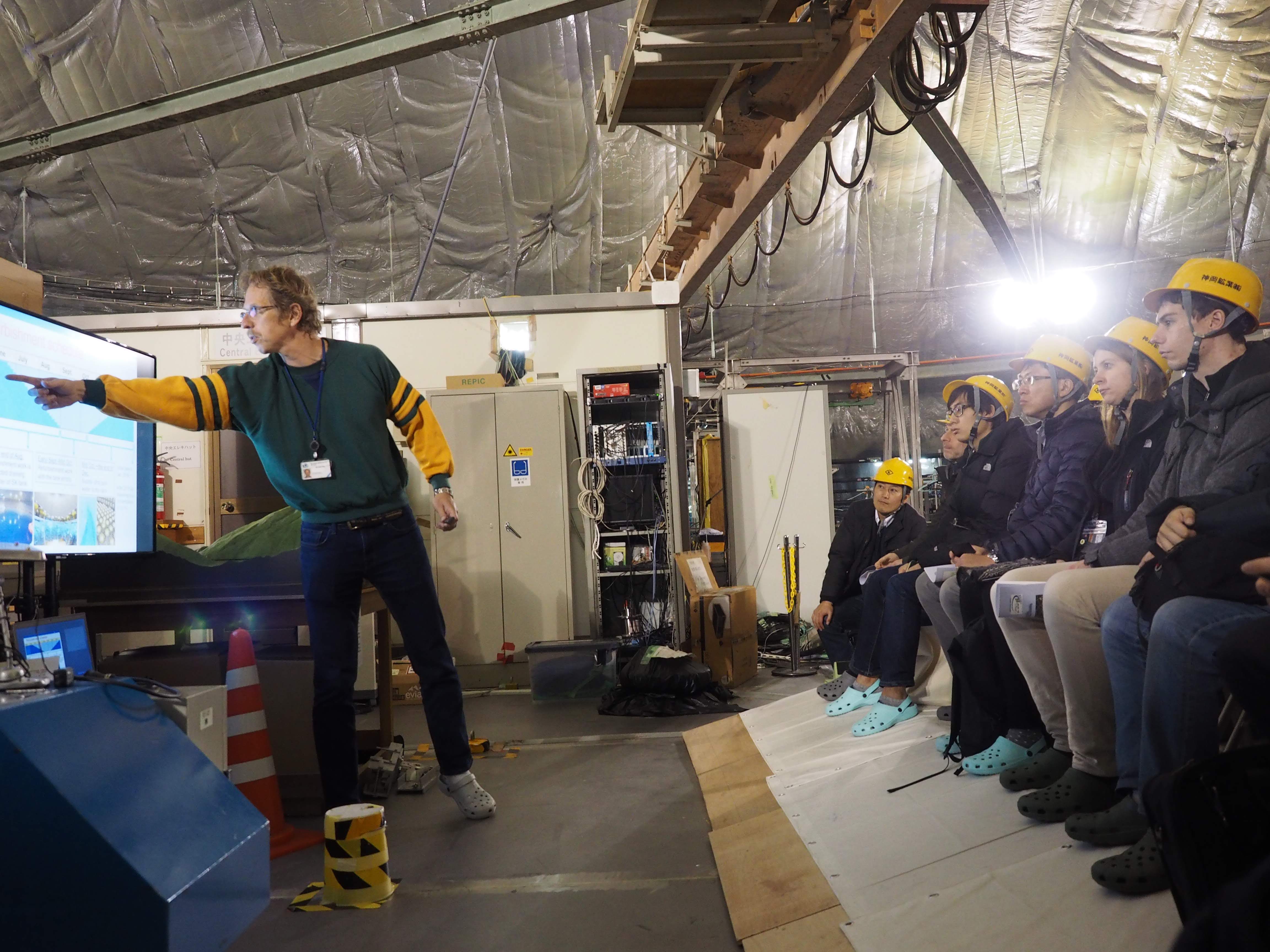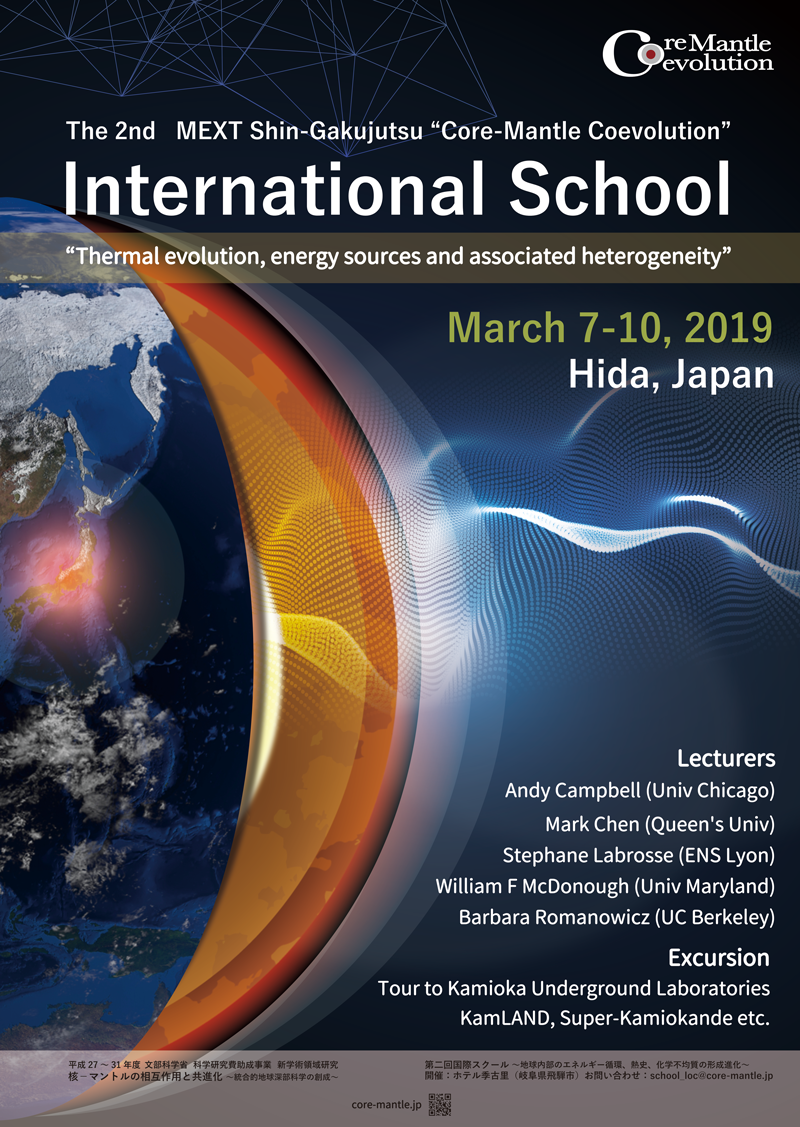The international school “Thermal evolution, energy sources and associated heterogeneity” was held from March 7th till March 10th in Hida, Japan.



I enjoyed and learned a lot during the winter international school at Hida. In my research, I try to advance the understanding of the seismic anomalies at the core-mantle boundary, more specifically, ultra-low velocity zones, by conducting high-pressure and high-temperature experiments to study the physical properties of minerals. Therefore, I was particularly interested in the lectures given by Prof. Barbara Romanowicz, who is leading seismologist using seismic tomography to study the structure of the deep Earth. During the lectures and poster presentation, I had a chance to deepen the understanding of my own research by talking with real seismologists. I understood that people from seismology desire more collaborations with those studying mineral physics, and vice versa.
Liang Yuan (Tohoku University)
I am extremely satisfied with the Core-Mantle Coevolution International School in Hida. As a particle physicist working on geoneutrinos, I found it valuable to learn about the geology aspect of the topic of my research. The geoneutrino predictions come from and tie into so many areas in geology, such as geochemistry and seismology. I have learned a lot and felt like I have a better understanding of the global worth of my research. Merging the disciplines and collaborating improves the science, therefore such interdisciplinary schools and workshops are definitely necessary. I loved talking and sharing ideas with various people at the school and I found the lectures interesting and engaging. I hope that the connections I made and experience I gained during this school will be long lasting.
Ingrida Semenec (Queen’s University)
“Core-Mantle Coevolution” International School in Hida
-Thermal evolution, energy sources and associated heterogeneity-
= Important =
Information for participants:
Please visit the following link regularly to check updates.
https://en.core-mantle.jp/school2019
<<
Lecture movies are now available. If you would like to watch them, please contact the LOC.
Those are limited for private use and redistribution is strictly prohibited.
Contact: school_loc -at- core-mantle.jp
Scope
The Earth is a huge thermal engine releasing heat from deep to space. There are some heat sources for it, including gravitational energy stored at the formation of the Earth, through the growth of the inner core and the chemical evolution of the mantle, and decay heat of some radiogenic nuclides is also important one. All the dynamical processes in Earth’s interior are driven for the thermal energy transfer (as effective as possible), generating several classes of thermal and chemical heterogeneity. In this school, we have lectures on the Earth’s interior by world leading experts of different research disciplines, geochemistry, geodynamics, seismology, mineral physics, and high energy physics, from this point of view.
The school is held in the place near Kamioka underground observatory with support from the MEXT Core-Mantle Coevolution project. Kamioka is famous for some memorial measurements related mainly to high energy physics. The geoneutrinos measurement is one of them, which are generated through the decays of radiogenic nuclides (U, Th, and K) and were observed in 2005 for the first time in the world by using the KamLAND detector installed in Kamioka underground observatory.
| Date | March, 7-10, 2019 (4 days 3 nights) |
| Venue | Hotel Kikori (Website) |
| Excursion | Tour to Kamioka Underground Laboratories KamLAND, Super-Kamiokande etc. |
| Lecturers | Andrew Campbell (Univ Chicago) Mark Chen (Queen’s Univ) Stephane Labrosse (ENS Lyon) William F McDonough (Univ Maryland) Barbara Romanowicz (UC Berkeley) |
| Participants | Ph.D. students and postdocs (about 30 people expected) |
| Fees | The registration cost for lodging and meals at Hotel KIKORI is approximately 37,000 yen (roughly 330 USD) for three nights and four days. Payment can be made directly to the hotel when you check out. We will also collect 4,000 yen per person to cover entertainment expenses at the registration. ○Registration Fee : JPY 4,000 ○Accommodation Fee : approx. JPY 37,000 (for three nights and four days with meals) |
| Poster Session | Poster Maximum size of a poster is 90 cm (W) x 120 cm (H) printed in vertical. A0 (84.1 x 118.9 cm, 33.1 x 46.8 in) is recommended. Documents Submission * Abstract : Please use the templates provided on the internal web page for participants. The preferred file type is PDF. Download Template (docx) * 1-page slide : 1-min student presentation is planed. Please prepare 1-page slide which summarizes your poster. The preferred file type is PDF. Deadline and email address of submission 28, February, school_loc-at-core-mantle.jp |
| Contact | International School LOC (H. Watanabe, T. Iizuka, K. Ueki, T. Tsuchiya) school_loc -at- core-mantle.jp |
Time Table
MAP
Hotel Kikori
FYR, the following are information on the travel to Toyama.
1. Haneda Airport to Toyama Airport
ANA has direct flights. 4 flights/day
7:55-8:55, 9:40-10:40, 18:00-19:00, 19:50-20:45
It is easy to go to Toyama Station from Toyama Airport. Local bus or taxi are available. It takes ~20 min.
Around Toyama Station, there are lots of hotels and nice restaurants. Toyama is very good place to have fresh fish.
2. Narita Airport to Toyama Station
There is no flight from Narita Airport. Shinkansen (comfortable rapid train) is available from Tokyo area to Toyama station.
You need to change trains at Ueno or Tokyo station, and then take Shinkansen to go to Toyama.
Narita Airport – Ueno or Tokyo station (by Skyliner or Narita Express) : ~45 min
Ueno or Tokyo station – Toyama (by Shinkansen) : ~2h 30min
This webpage will be useful to check how to go to Toyama by trains.
>>http://www.hyperdia.com/en/
Here is a link to share the map around Toyama and lists of visiting places.






